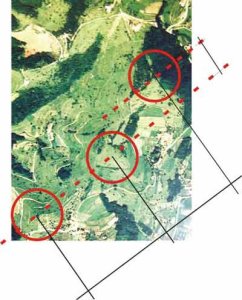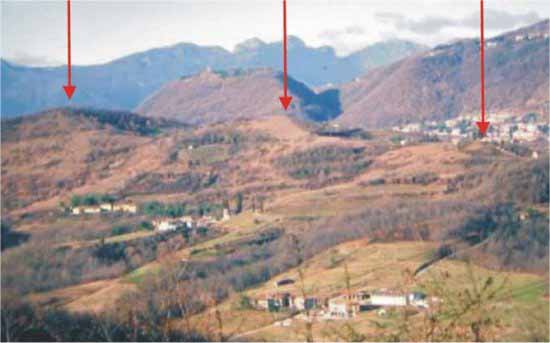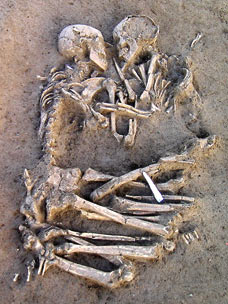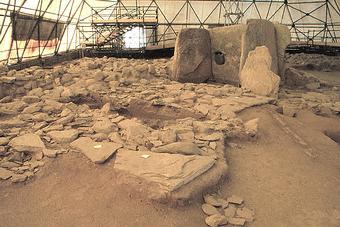Italian Pyramids..?
Three 'pyramids' were
discovered thanks to satellite and aerial imagery in
northern Italy, in the town of Montevecchia - 40 km
from Milan.

 They
are the first pyramids ever discovered in Italy and the
dimensions are quite impressive; the highest pyramid is
150 meters tall. They are stone buildings, as recent
excavations have proved. However, they are now
completely covered by ground and vegetation, so that
they now look like hills.
They
are the first pyramids ever discovered in Italy and the
dimensions are quite impressive; the highest pyramid is
150 meters tall. They are stone buildings, as recent
excavations have proved. However, they are now
completely covered by ground and vegetation, so that
they now look like hills.
The inclination degree
of all the three pyramids is apparently 42
�
43' (As seen on the 'Bent' and 'Red'
pyramids at
Dashur) and it has been suggested that there is a
perfect alignment with the Orion constellation (a
suggestion which appears valid, if the photo - right is
correct). There appear to be similarities with the
Egyptian pyramids. At the moment, little is known about
their origin or age.
(Other
European Pyramids)
The Lovers of
Valdaro :
 Article:
DailyMail. (Feb, 2007)
- ROME.
Article:
DailyMail. (Feb, 2007)
- ROME.
Two 5,000-year-old
skeletons have been found locked in an embrace near the city where
Shakespeare set the tale ROMEO AND JULIET. At present,
they are the only couple found embracing from the
Neolithic.
Archaeologists unearthed the skeletons dating back to
the late Neolithic period outside Mantua, 25 miles south
of Verona, the city of Shakespeare's story of doomed
love. Buried between 5,000 and 6,000 years ago, the pair
are believed to have been a man and a woman and are
thought to have died young, because their teeth were
found intact, said Elena Menotti, the archaeologist who
led the dig. "As far as we know, it's unique," Menotti
said. "Double burials from the Neolithic are unheard
of, and these are even hugging."
An initial examination of the couple - dubbed the Lovers
of Valdaro - revealed that the man (on the left in the
picture) has an arrow in his spinal column while the
woman has an arrow head in her side.
San Martin De
Corleans:
The monuments at Saint
Martin de Corl�ans, which date back to the 3rd
millennium BC, indicate that it was a very important
place for several thousand years.
The construction of the
site began between 2,000 and 4,750 B.C. with the
planting of a series of wooden poles. Before this
planting, the ashes of burnt ox skulls were spread at
the bottom of the pits that held the poles. The various
rows of poles are aligned towards a rock on the mountain
in front of the site. The most likely explanation for
this alignment is that the ancient inhabitants of the
valley noticed that the rock in question just hides the
Moon on the rare occasions when it dips to its lowest
angle below the celestial equator.
The second phase
(2,750-2,400 B.C) started with an extensive ritual
ploughing, whose lines are parallel to the orientation
of the wooden poles. The ploughed area yielded a large
number of human teeth, apparently planted as though they
were seeds. Several statue-stele (human figures carved
on big stone slabs) were also erected in the same
period. Some of these were aligned with the poles and
the ritual ploughing, while others were set at
right-angles to the alignment. In addition, a number of
standing stones, stone platforms and at least seven big
ritual pits were added during the same construction
phase.
 The
third phase, between 2,400 and 2,100 B.C., saw the
construction of a big dolmen (2.5 x 2.2 m, or about 8.2
x 7.2 feet) with a side entrance and a 15m (49 feet)
triangular stone platform, followed by a second smaller
dolmen, an all�e couverte (a tomb that looks like an
elongated dolmen) and a circular tomb. All these
monuments were left without a covering mound, just like
the Caucasian and Palestinian tombs.
The
third phase, between 2,400 and 2,100 B.C., saw the
construction of a big dolmen (2.5 x 2.2 m, or about 8.2
x 7.2 feet) with a side entrance and a 15m (49 feet)
triangular stone platform, followed by a second smaller
dolmen, an all�e couverte (a tomb that looks like an
elongated dolmen) and a circular tomb. All these
monuments were left without a covering mound, just like
the Caucasian and Palestinian tombs.
The tombs at Saint Martin
de Corl�ans are usually aligned to local astronomical
points, in particular the sunset at summer solstice and
the moonset when the Moon reaches its northernmost
position. Several smaller tombs were built during a
fourth construction phase (2,100-1,900 B.C). The site
was then deserted for about 700 years, but from 1,200 to
800 B.C. was again used as a burial ground.
For more than two
thousand years, the
area was used as a
cemetery,
Rome: Home of
the Obelisk.
The
city of Rome currently harbours the most obelisks in the
world. There are eight ancient Egyptian and five ancient
Roman obelisks in Rome, together with a number of more
modern obelisks; there was also (until it was returned
in 2005) an ancient Ethiopian obelisk from
Axum in Rome.

The tallest
Egyptian obelisk is in the square in front
of the Lateran Basilica in Rome at 105.6
feet tall and a weight of 455 tons.